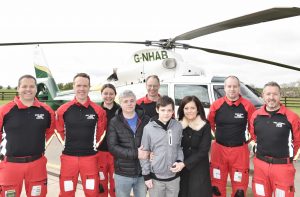Kacper Krause, 13, of Appleby, was submerged in cold river water for around 25 minutes before being pulled out by brave staff from the town’s fire service. He had drowned.
In years gone by, the schoolboy would not have had a chance of survival. But thanks to specialist equipment and the expertise of healthcare staff, Kacper is making a strong recovery.
Last week, just two months after the incident, he walked into the Great North Air Ambulance Service base at Langwathby to thank the charity’s critical care team.
One of the most significant factors in Kacper’s survival was the use of Extracorporeal Membrane Oxygenation (ECMO) – a service which in this region is only available at the Freeman Hospital in Newcastle.
Having had previous experience of children surviving because of ECMO, the team from the Great North Air Ambulance Service knew it was Kacper’s best chance of survival.
Read more: GNAAS crew recall schoolboy’s miraculous rescue
The charity employs doctors from hospitals throughout its region, and in the aftermath of the incident, one of those doctors, Amy Gospel, was part of the ECMO critical care team who witnessed Kacper’s miraculous recovery.


Amy, clinical fellow in paediatric intensive care at the Freeman Hospital in Newcastle and GNAAS doctor, explains how the story will prove to be a lasting inspiration.
“I met Kacper and his family on his first day in hospital, whilst he was receiving ECMO support.
The ECMO machine is able to carry out the functions of both the heart and lungs, to provide blood flow and oxygen the body. A cannula tube takes the patient’s blood out of a large vein, to pass through the machine.
An external pump does the role of the heart, and blood passes a membrane that oxygenates the blood and removes carbon dioxide, doing the usual job of the lungs. The blood then goes back into the body through a tube in a large artery.
“In addition, the machine also warms the blood. This is a vital part of the process as in order for vital organs of the body to work they need to be at or approaching 37 degrees. Kacper had cooled significantly whilst submerged. ECMO is an efficient way of raising a patient’s body temperature quickly and safely.
“When we use ECMO treatment during cardiac arrest in hospital, we use ice to cool and help preserve the brain, whilst it is not receiving blood flow and oxygen. In Kasper’s case the cold river water helped to provide this protective cooling.
“Nevertheless, we knew the brain had been starved of oxygen for a certain amount of time, and damage to the cells would have occurred. Sedation during this time helps to optimise conditions for the brain to recover.
“A successful outcome in such case lies in the chain of care received, involving expert care at all stages of his treatment and recovery.
I have no doubt that my GNAAS colleagues had massive impact on his outcome through early recognition that ECMO would be best treatment, rapid transport to Newcastle to enable this, and providing effective CPR whilst his own heart was not beating.
“It’s an amazing case. When you are speaking to parents and families in hospital in the aftermath of such incident, it is really important we give realistic expectations. In the hours after the incident, the most likely outcome that we had to prepare his family for was that Kacper would not survive, and if he did he may not have a good neurological outcome. That could mean impaired thought processes and learning, movement, communication, and ability to care for himself. All parents and loved ones in such situations are desperate for positive news, but we would be doing them a disservice to tell them only what they wanted to hear. I just wanted to hug Kacper’s mum and tell her everything was going to be alright, but at that point all I could do was encourage her not to lose hope.
“I was so pleased to hear a couple of weeks ago that he had left hospital. It was remarkable to see him walk into the base and tell us himself about how his recovery is progressing, as well as share a smile and joke.
Kacper has a truly inspiring story of amazing outcomes possible from the bleakest of circumstances. To see Kacper and his parents today, reminds us all of why we do what we do.”
GNAAS is reliant on donations to survive. To donate today, please click here.
How is ECMO delivered?
ECMO services require a skilled team of people both to establish ECMO and provide ongoing care in the Intensive Care Unit.
These include:
Surgeon – establishes and secures a series of cannula tubes into large veins and arteries in the body, to connect the patient’s circulation to the ECMO machine.
Anaesthetic / Critical Care Doctors – oversee all aspects of the patient’s physiology and provision of support to the different body organs.
Perfusionist – an expert in the construction and running of the ECMO circuit.
Critical Care Nurses – provide ongoing monitoring of the patient and ECMO machine, administer drugs and provide all aspects of care to patients.
Within the region ECMO is most commonly used to support children undergoing complex heart surgeries, to enable the heart and lungs to recover after the physiological stresses of the surgery.
Summary
GNAAS wishes to recognise the substantial involvement of all involved in Kacper’s rescue, from the fire, police and ambulance staff on scene, through to all those in hospital and any one else who played a part in this remarkable team effort.



